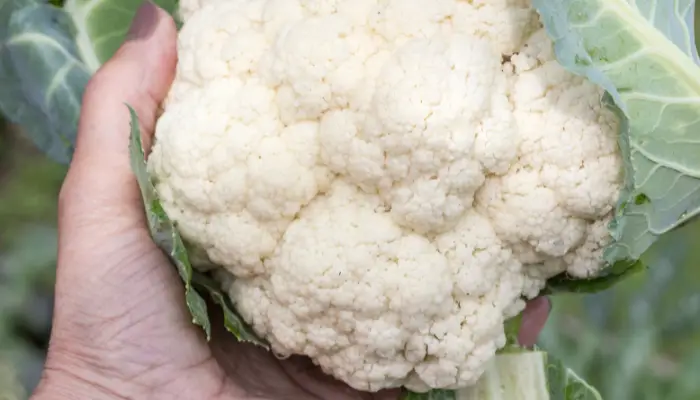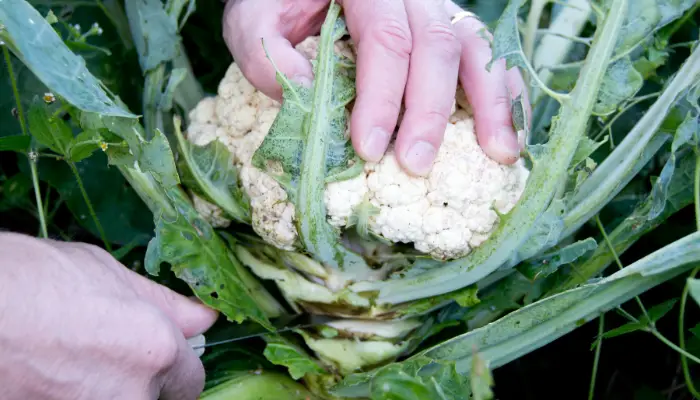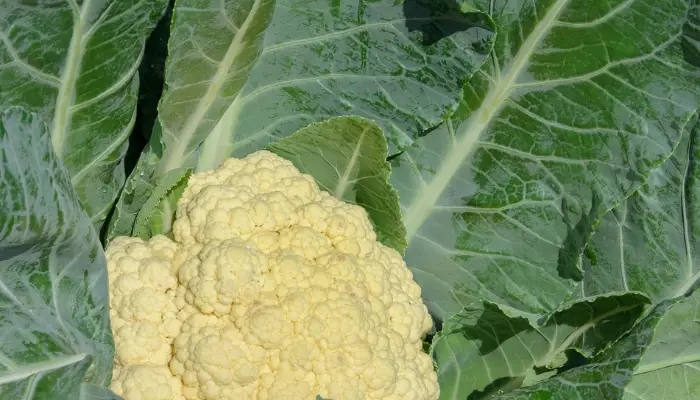Cauliflower is a nutritious and versatile vegetable that belongs to the brassica family, along with broccoli, cabbage, kale, and brussels sprouts.
It is rich in vitamin C, antioxidants, fiber, and other beneficial compounds that can support your health and wellness.
However, if you grow your own cauliflower, you may have noticed that sometimes the white heads turn yellow and lose their appeal.
Why does this happen and how can you avoid it? In this blog post, I will explain the main causes of yellowing cauliflower and share some tips on how to prevent it.

The Main Cause of Yellowing Cauliflower: Sun Exposure
The most common reason why cauliflower heads turn yellow is because they are exposed to too much sunlight. Cauliflower plants are sensitive to light, and they need to be protected from the sun’s rays to maintain their white color.
If the sun hits the cauliflower head for too long, it can trigger a chemical reaction that produces pigments called carotenoids, which give the cauliflower a yellow hue.
This discoloration does not affect the taste or the nutritional value of the cauliflower, but it does make it look less appetizing and attractive.

How to Prevent Yellowing Cauliflower: Blanching
The best way to prevent yellowing cauliflower is to blanch the heads, which means covering them with their own leaves to block out the light.
This can be done manually or by choosing self-blanching varieties. Manual blanching involves tying the outer leaves of the cauliflower plant over the head with a rubber band, a piece of string, or a peg when the head is about 2 inches in diameter.
This will create a dark environment for the cauliflower head, preventing it from turning yellow. You should check the heads daily and harvest them when they are about 8 inches in diameter before they start to loosen and spread.
Self-blanching varieties are cauliflower plants that naturally produce leaves that cover the head, without the need for manual intervention. These varieties are more convenient and easier to grow, as they do not require constant attention and care. Some examples of self-blanching varieties are Snowball, Snow Crown, Skywalker, Apex, and Fremont.
Other Factors That Can Cause Yellowing Cauliflower
Besides sun exposure, other factors can cause yellowing cauliflower, such as:
- Soil pH: Cauliflower plants prefer a slightly acidic soil, with a pH between 6.0 and 6.5. If the soil is too alkaline, it can affect the absorption of nutrients and cause yellowing of the leaves and the head. You can test the soil pH with a kit and adjust it with lime or sulfur, depending on the results.
- Temperature: Cauliflower plants thrive in cool and moist conditions, with optimal temperatures between 60 and 70 degrees Fahrenheit. If the temperature is too high or too low, it can stress the plants and cause yellowing of the head. You can protect the plants from extreme temperatures by using mulch, row covers, or shade cloth.
- Pests and diseases: Cauliflower plants can be attacked by various pests and diseases, such as aphids, cabbage worms, flea beetles, clubroot, black rot, and downy mildew. These can damage the plants and cause yellowing of the leaves and the head. You can prevent and control pests and diseases by using organic methods, such as crop rotation, companion planting, beneficial insects, and natural sprays.

How To Know When Cauliflower is Ready to Harvest?
The best time to harvest cauliflower is when the head is white, firm, and large, usually about 6 to 12 inches (15 to 31 cm) in diameter.
You should cut the head from the base of the plant with a sharp knife, leaving some leaves attached to protect it. You can also soak the head in salt water for 20 to 30 minutes to remove any insects.
Some Common Problems With Cauliflower?
Some common problems with cauliflower are:
- Failure to form heads: This can be caused by too much nitrogen, insufficient sunlight, inadequate moisture, or poor drainage. To avoid this, plant cauliflower in well-drained soil, fertilize moderately, and provide at least six hours of direct sun, and water regularly.
- Yellowing of heads: This can be caused by too much sun exposure, which triggers the production of yellow pigments. To prevent this, blanch the heads by covering them with their own leaves, or choose self-blanching varieties that naturally protect the heads.
- Fuzzy or riced heads: This can be caused by sudden changes in temperature or water, which stress the plants and cause them to produce small, loose, and grainy heads. To prevent this, plant cauliflower in cool and moist conditions, avoid transplanting when the temperature is below 5°C, and water evenly.
- Pests and diseases: Cauliflower can be attacked by various insects and fungi, such as aphids, cabbage worms, flea beetles, clubroot, black rot, and powdery mildew. These can damage the plants and cause yellowing, wilting, or rotting of the leaves and heads. To prevent and control pests and diseases, use organic methods, such as crop rotation, companion planting, beneficial insects, and natural sprays.
For more details, you can check out these web pages: How to Identify and Treat Common Cauliflower Diseases – Gardener’s Path, 19 Common Cauliflower Plant Problems.

Why is My Cauliflower Yellow
How to Store Harvested Cauliflower?
There are three main ways to store your harvested cauliflower: in the refrigerator, in the freezer, or in vinegar. Here are some brief instructions for each method:
- In the refrigerator: Loosen the plastic wrap around the cauliflower head and store it stem-up in the crisper drawer. It should last for three to five days. You can also cut up the cauliflower into florets and store them in an airtight container for four or five days.
- In the freezer: Cut up the cauliflower into florets and blanch them in boiling water for three minutes, then plunge them into ice water. Drain well, pat dry, and freeze them on a baking sheet. Once frozen, transfer them to a freezer bag and keep them for up to a year.
- In vinegar: Cut up the cauliflower into florets and pickle them in a vinegar solution with salt, sugar, and spices. You can also add other vegetables like carrots, peppers, and olives. Store the pickled cauliflower in a jar in the refrigerator for up to a month, or can it for longer shelf life.
Summary
Cauliflower is a delicious and healthy vegetable that can be enjoyed in many ways.
However, if you grow your own cauliflower, you may encounter the problem of yellowing heads, which can reduce the appeal and quality of your harvest.
The main cause of yellowing cauliflower is sun exposure, which can be prevented by blanching the heads with their own leaves. You can also avoid yellowing cauliflower by choosing self-blanching varieties, maintaining the right soil pH and temperature, and protecting the plants from pests and diseases.
Frequently Ask Questions about Yellow Cauliflower
1. Is yellow cauliflower safe to eat?
Absolutely! Yellow cauliflower is safe to eat. The yellow color is often due to natural pigments, such as beta-carotene, and doesn’t indicate spoilage. However, always check for signs of mold or a rancid odor, as these could be indicators of spoilage.
2. Does the yellow color affect the taste of cauliflower?
In most cases, the yellow color in cauliflower doesn’t significantly alter its taste. However, cauliflower that has been sun-scalded might have a slightly different flavor and texture. Some people even argue that different-colored cauliflowers have unique taste profiles, providing an opportunity to explore diverse culinary experiences.
3. Why does cauliflower turn yellow when exposed to sunlight?
Cauliflower turns yellow when exposed to sunlight due to a process called sun scalding. Direct sunlight causes the breakdown of chlorophyll in the cauliflower, revealing the yellow pigments underneath. While this doesn’t compromise the safety or edibility of the vegetable, it’s an interesting phenomenon related to its exposure to light.
4. Does the nutritional content change with the color of cauliflower?
Yes, the nutritional content can vary slightly depending on the color of cauliflower. Yellow cauliflower, in particular, tends to have higher levels of beta-carotene, which is a precursor to vitamin A. This can contribute additional health benefits to your diet, supporting vision, skin health, and immune function.
5. Can I cook yellow cauliflower the same way I cook white cauliflower?
Absolutely! Yellow cauliflower can be cooked in the same ways as its white counterpart. Whether you prefer roasting, steaming, sautéing, or mashing, the cooking methods remain the same. Feel free to experiment with recipes and cooking techniques to find the preparation style that suits your taste preferences.
6. Is there a difference in the nutritional value between yellow and white cauliflower?
Yes, there can be slight differences in nutritional content. Yellow cauliflower may contain higher levels of beta-carotene, while white cauliflower might have a milder flavor. However, both varieties are nutritious and provide essential vitamins and minerals.
7. How can I prevent cauliflower from turning yellow during storage?
To minimize the risk of cauliflower turning yellow during storage, keep it in a cool, dry place, and preferably refrigerate it. Use cauliflower within a reasonable time frame to ensure optimal freshness and flavor. If you notice discoloration, trim away the affected parts before cooking.




